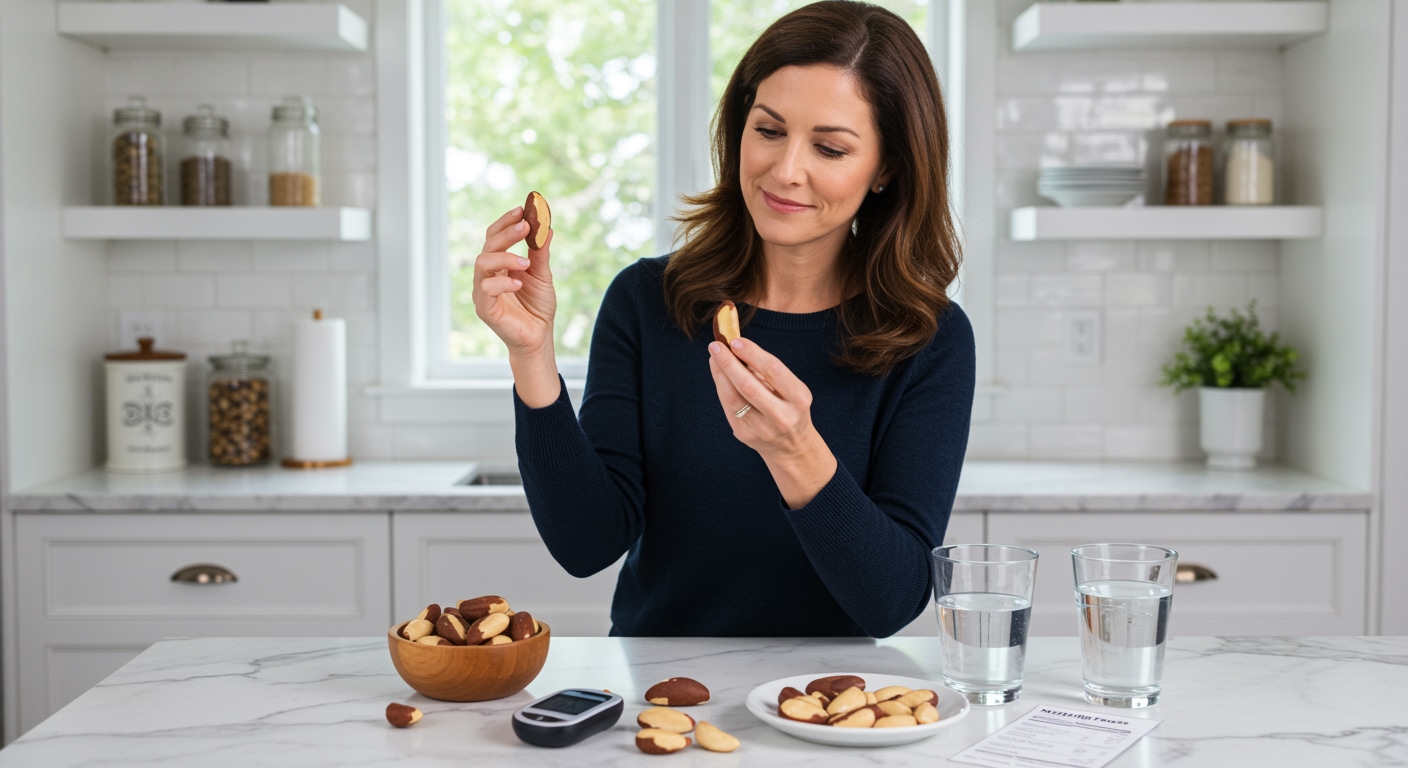✪ Key Takeaway: Brazil nuts are excellent for diabetes due to their low glycemic index, high selenium content, and blood sugar stabilizing effects.
Introduction
You grab a handful of Brazil nuts from the pantry and wonder if they will spike your blood sugar.
This question crosses your mind because managing diabetes means being careful about every food choice you make.
Hi, I am Abdur, your nutrition coach and today I am going to explain everything you need to know about Brazil nuts and diabetes management.
What Makes Brazil Nuts Different From Other Nuts?
Brazil nuts stand out from other nuts because they contain the highest selenium content of any food on Earth.
Just one Brazil nut provides about 96 micrograms of selenium, which exceeds your daily requirement of 55 micrograms.
This selenium powerhouse acts as a potent antioxidant that protects your cells from damage caused by high blood sugar levels.
The nutritional profile of Brazil nuts includes healthy fats, protein, fiber, and minimal carbohydrates.
Each ounce contains only 3.3 grams of carbohydrates, making them a low-carb option that fits well into diabetes meal plans.
✪ Fact: Brazil nuts grow only in the Amazon rainforest and cannot be cultivated elsewhere due to their complex pollination requirements.
How Do Brazil Nuts Affect Blood Sugar Levels?
Brazil nuts have a glycemic index of 10, which places them in the low glycemic category.
Foods with a glycemic index below 55 cause minimal blood sugar spikes, making Brazil nuts an excellent choice for people with diabetes.
The high fiber content in Brazil nuts slows down digestion and helps prevent rapid glucose absorption into your bloodstream.
Research shows that the healthy fats in Brazil nuts can improve insulin sensitivity over time.
When your cells become more sensitive to insulin, they can use glucose more effectively, leading to better blood sugar control.
The protein content in Brazil nuts also helps stabilize blood sugar by slowing the absorption of any carbohydrates you eat with them.
✪ Pro Tip: Eat Brazil nuts with meals containing carbohydrates to help slow glucose absorption and reduce blood sugar spikes.
What Role Does Selenium Play In Diabetes Management?
Selenium acts as a powerful antioxidant that protects your pancreatic beta cells from oxidative stress.
These beta cells produce insulin, and protecting them is crucial for maintaining healthy blood sugar levels.
Studies indicate that people with diabetes often have lower selenium levels in their blood compared to healthy individuals.
Selenium deficiency can worsen insulin resistance and make blood sugar control more difficult.
The selenium in Brazil nuts helps activate glutathione peroxidase, an enzyme that neutralizes harmful free radicals in your body.
This process reduces inflammation, which is often elevated in people with diabetes and contributes to insulin resistance.
Regular selenium intake through Brazil nuts may help improve your overall diabetes management by supporting your natural antioxidant systems.
✪ Note: Too much selenium can be toxic, so limit yourself to 1-2 Brazil nuts per day to avoid exceeding safe intake levels.
How Many Brazil Nuts Should You Eat With Diabetes?
The ideal serving size for people with diabetes is 1-2 Brazil nuts per day.
This amount provides adequate selenium without risking toxicity or consuming too many calories.
Each Brazil nut contains approximately 33 calories, so two nuts add only 66 calories to your daily intake.
The portion control is important because Brazil nuts are calorie-dense, and excess calories can lead to weight gain.
Weight management plays a crucial role in diabetes control, so maintaining appropriate portions helps you achieve both nutritional benefits and weight goals.
You can eat your Brazil nuts as a snack between meals or add them to salads and other dishes for extra nutritional value.
✪ Pro Tip: Store Brazil nuts in the refrigerator to prevent rancidity and maintain their nutritional quality for longer periods.
Are There Any Risks Or Side Effects To Consider?
The main risk with Brazil nuts comes from selenium toxicity if you eat too many.
Consuming more than 400 micrograms of selenium daily can cause symptoms like hair loss, nail brittleness, and digestive issues.
Since just four Brazil nuts can exceed this limit, sticking to 1-2 nuts daily keeps you in the safe range.
Brazil nuts are also high in saturated fat, with each nut containing about 1.8 grams.
While this amount is not excessive in small portions, people with heart disease should monitor their total saturated fat intake.
Some people may experience allergic reactions to tree nuts, including Brazil nuts.
If you have never eaten Brazil nuts before, start with a small amount to test your tolerance.
✪ Note: Always consult your healthcare provider before adding new foods to your diabetes management plan, especially if you take medications.
The Bottom Line
Brazil nuts are an excellent addition to a diabetes-friendly diet when consumed in appropriate portions.
Small portions of nutrient-dense foods often provide the biggest health benefits, and Brazil nuts perfectly demonstrate this principle.
I would love to hear about your experience with Brazil nuts or any questions you might have about incorporating them into your diabetes management plan, so please share your thoughts in the comments below.
References
At NutritionCrown, we use quality and credible sources to ensure our content is accurate and trustworthy. Below are the sources referenced in creating this article:
- PMC: Selenium and Diabetes
- FoodStruct: Brazil Nuts Nutrition Facts
- PubMed: Selenium Status in Diabetes
- January AI: Brazil Nuts Glycemic Index





